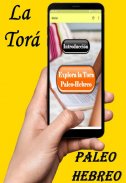






La Torá Paleo-Hebreo Gratis

وصف لـLa Torá Paleo-Hebreo Gratis
El "paleohebreo" es una rama del alfabeto semítico antiguo y relacionado cercanamente al alfabeto fenicio. Se remonta al siglo X a.C. o antes. Fue empleada como escritura del idioma hebreo por los Israelitas, quienes más tarde se dividirían en los judíos y samaritanos.
Los judíos reemplazaron el "alfabeto" paleo-hebreo por el hebreo cuadrado.
Los Samaritanos, que ahora suman menos de mil personas, siguen utilizando un derivado del "alfabeto" paleohebreo, conocido como el alfabeto samaritano.
La inscripción más antigua que se conoce del alfabeto paleohebreo fue descubierta en la piedra de la pared en Tel Zayit, en el Valle Beth Guvrin en las tierras bajas de la antigua Judea. Las 22 letras fueron talladas en un lado de la piedra de 38 lb (17 kg).
La siguiente sería el calendario de Gézer fechado a finales del siglo X a.C. La escritura del calendario Gézer tiene gran parecido a las semejantes inscripciones fenicias contemporáneos de Biblias. Son visibles claras características hebreas en la escritura de las inscripciones moabitas de la Estela Mesa.
En esta app encontraras la "Torá PALEO-HEBREO" completa.
Espero que te sea de mucha ayuda para el estudio del antiguo hebreo.
The "paleohebreo" is a branch of the ancient Semitic alphabet and closely related to the Phoenician alphabet. It goes back to the 10th century B.C. or before. It was used as a writing of the Hebrew language by the Israelites, who would later be divided into Jews and Samaritans.
The Jews replaced the Paleo-Hebrew "alphabet" with the square Hebrew.
The Samaritans, who now number less than a thousand people, continue to use a derivative of the Paleo-Hebrew "alphabet", known as the Samaritan alphabet.
The oldest known inscription of the Paleo-Hebrew alphabet was discovered on the stone wall in Tel Zayit, in the Beth Guvrin Valley in the lowlands of ancient Judea. The 22 letters were carved on a side of the 38 lb (17 kg) stone.
The following would be Gézer's calendar dated at the end of the 10th century B.C. The writing of the Gézer calendar resembles the similar contemporary Phoenician inscriptions of Bibles. Clear Hebrew characteristics are visible in the writing of the Moabite inscriptions of the Estela Mesa.
In this app you will find the complete "Torah PALEO-HEBREW".
I hope you find it helpful to study the ancient Hebrew.

























